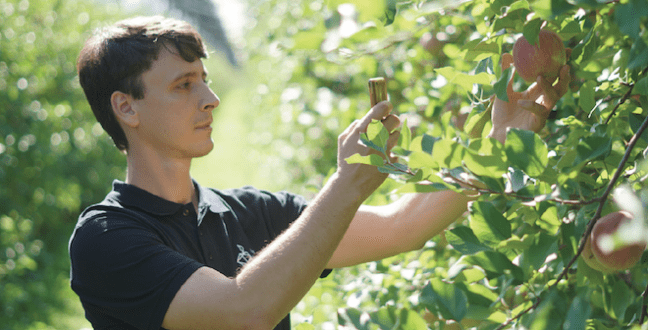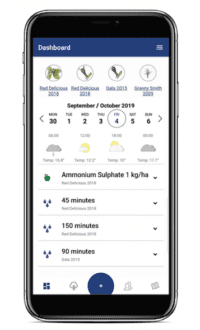

Dec 23, 2019MapMyApple offers orchard organization, problem diagnosis
Commercial orchards are often a patchwork quilt – blocks with different cultivars, planted in different years. Varieties have different schedules with various bloom times and harvest times. A disorganized grower risks getting lost in all of those details.
MapMyApple, a smartphone application that’s new in the North American market this winter, promises to help growers stay on top of what’s happening in their own orchards.
Available through Google Play – and, developers say, soon the iPhone App Store – MapMyApple is free for a 30-day trial period. Users pay a monthly subscription fee for continued access. So far, the app has roughly 1,500 downloads.
Although the app was developed in Europe, Fresh Agriculture Technologies is a startup company incorporated in San Francisco, and MapMyApple is also being marketed to growers in South Africa.
Marketing Manager Jovanna Dordic said the app makes suggestions based on growers’ input. Growers manually enter data about tree thickness, year of planting, apple variety, soil composition and location. Algorithms and machine-learning technology develop daily suggestions that are reviewed by the staff before being sent on to growers, she said.


The application makes daily recommendations on irrigation, fertigation and plant protection.
“When it comes to production, we have image recognition technology for pests and disease,” Dordic said. Growers upload photos of disease or pest damage, and receive a diagnosis and treatment recommendation.
“This is the most interesting feature for our users, for now,” she said. “That is the biggest problem, I think for every apple grower in agriculture.”
Another favorite feature is satellite imagery of a farm that refreshes every seven days.
“Our users really like it, because they can see their orchard in color,” Dordic said.
CEO David Blazevski said he developed the app in part due to his experiences on a small family farm in Serbia. His family, who grew apples as a side business, would often use a variety of sources – social media, friends and neighbors – to plan harvests, sprays or other time-sensitive orchard work.
Those decisions were important, he remembers, and professional opinions were expensive. It would cost 90-100 Euros ($99 to $110) to pay for a field visit from a professional agronomist.
“If you don’t know what to do, you can make big trouble,” Blazevski said.
The app is marketed at small-to-medium growers who are looking to boost their yield-per-acre figure closer to that of the larger growers who have more staff and professional advice.
“Our goal is to make them champions of apple growing,” she said.
Large and respected professional growers in Europe are helping to improve the app.
Stefan Manja is a tree fruit specialist and representative of Delta Agrar – the largest apple grower in Serbia, with roughly 1,2000 acres of apples in addition to other crops such as sweet cherries and plums.
Manja is helping to test the app and give feedback on the automatic diagnosis. He said he’d found “only some slight nuances,” or subtle differences, in the advice to treat pests.
Having grown apples in addition to working with Delta Agrar, Manja said a daily plan for tending to crop production comes in handy.
“I found it interesting as a reminder not to forget any task,” he said. “Where the app had an advantage over humans in the company was that – with people it can happen from time to time – with so many orchard blocks, with so many years of planting, so many different varieties, it’s easy to miss the right moment to make a decision, being overwhelmed with data.”
Manja said the app can recognize damage from a variety of pests and diseases, including Alternaria leaf spot, various leaf aphids including wooly aphids, codling moths, fire blight symptoms, brown marmorated stink bugs, Monilia, apple canker, powdery mildew, spider mites and blossom weevil.
“That’s what’s been implemented so far, and it’s been tested, and we’re continuously improving the recognition system … making it more precise,” he said. They continue to talk to growers about what their concerns and priorities are. “It’s fun to sit together and see what we can improve even further.”
— Stephen Kloosterman, associate editor














